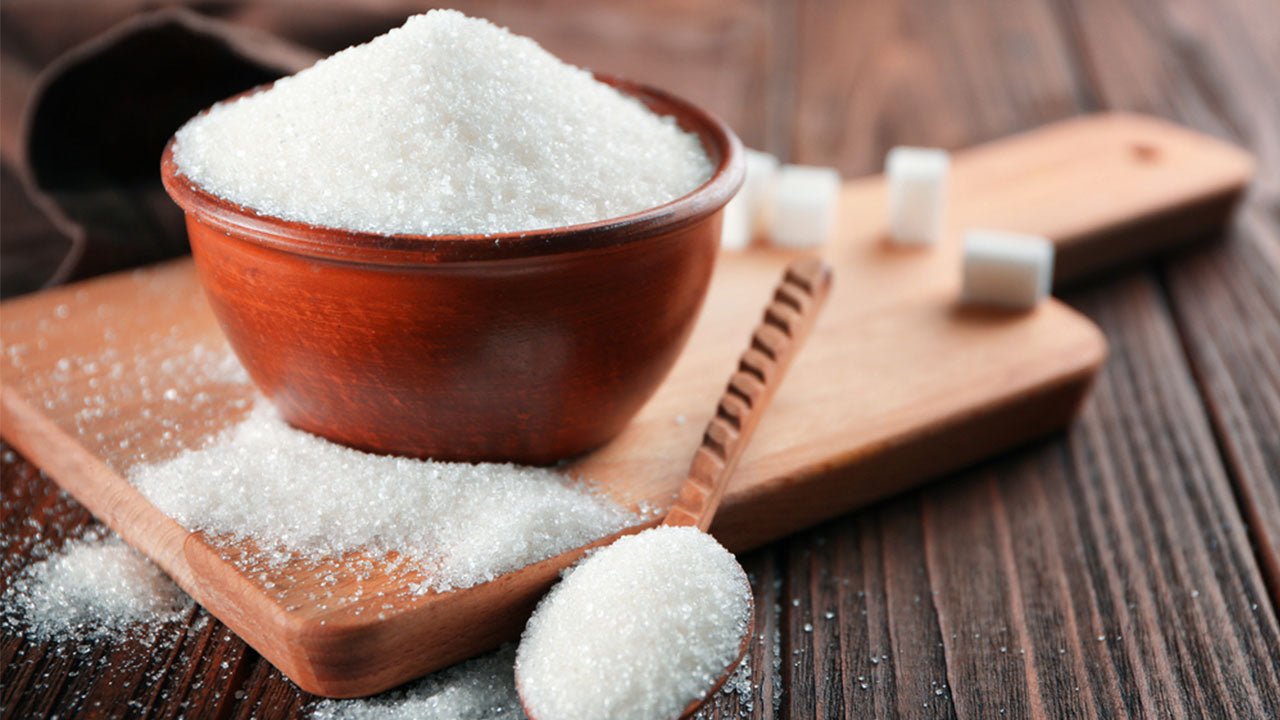Excess Sugar Consumption—What’s the Price You Pay?
 By: by Amino Science
By: by Amino Science

Sugar makes so many things in life sweet—cupcakes, chocolate, cotton candy, lemonade! The list goes on and on… But what is the price we pay for this indulgence? Is it worth the myriad health problems that can occur as a consequence of excess sugar intake? In this article, we’re going to uncover the facts behind America’s sugar addiction, discuss the potential health effects associated with too much sugar, and make the case for moderating our sugar consumption.
How Much Sugar Is Okay?
There’s no denying that most of us love sugar. Not only does it taste good, but it’s also packed with energy, it helps our bodies hang on to fat, and it stimulates the release of mood-boosting dopamine.
Without sugar, our prehistoric ancestors may not have had the calories they needed to live long enough to pass on their genes. So it’s no wonder we evolved to love the taste. But in a world where food is abundant, sugar can become a double-edged sword.
Even so, some sugar intake is perfectly fine, though it’s still helpful to understand exactly how much is too much.
According to the 2015-2020 Dietary Guidelines for Americans, published by The Office of Disease Prevention and Health Promotion (ODPHP), it’s recommended that the number of calories consumed as added sugar equal less than 10% of total daily calories. So for the average American eating 2,000 calories per day, for example, this would amount to 200 calories, or about 12 teaspoons of sugar.
The American Heart Association (AHA) guidelines are even more stringent. Based on the same 2,000-calorie diet, the AHA guidelines recommend a limit for women of 100 calories every day (approximately 6 teaspoons of sugar) and a limit for men of 150 calories (approximately 9 teaspoons of sugar).
It’s important to note that “added” is the operative word here because it indicates that the naturally occurring sugars in fruits, vegetables, and dairy products don’t count toward total sugar intake.
However, this doesn’t include raw sugar, like the packets of turbinado sugar you pour in your venti cappuccino. And it certainly doesn’t apply to the highly processed high-fructose corn syrup found in many cereals, cookies, ice creams, soft drinks, and even sports drinks and energy drinks!
In other words, “naturally occurring sugar” refers only to the sugar that’s found in whole foods—not what you see in processed foods and beverages.
From corn sweeteners to fruit juice to the table sugar you probably use at home, you may be surprised at the many different forms sugar can take in your food. So you can probably understand why it’s easy for the total amount of sugar you eat to add up quickly and tip you way over the scales of healthy sugar consumption.
Sugar Consumption: A Case for Moderation
Let’s now review some basics about sugar to understand why we should enjoy this sweet treat in moderation.
Sugar, or sucrose, is classified as a simple carbohydrate because of its chemical structure and the speed at which it’s digested and absorbed (relative to complex carbohydrates).
The ultimate fate of a carbohydrate, whether it’s in the form of oatmeal or an Oreo, is to be broken down to the simplest monosaccharide structure—glucose, fructose, and galactose being the three most common.
Much of the sugar we eat is transformed in the body to glucose, which circulates in the blood and is delivered to tissues and organs (including the brain) to provide energy. This process occurs via a rather complex metabolic pathway called the tricarboxylic acid (TCA) cycle.
The concern regarding simple sugars doesn’t have anything to do with this part of carbohydrate metabolism since every carbohydrate proceeds down the same path once it’s digested and absorbed. Rather, the concern lies in the fact that simple carbohydrates are digested and absorbed more quickly than complex carbohydrates, and this leads to bigger spikes in blood glucose level (BGL).
The body handles increases in BGL by releasing insulin, which assists in the uptake of glucose into tissues and muscle. When we’re young and healthy and active, this process is exquisitely controlled, and even a sharp spike in BGL is managed effectively.
However, obesity and inactivity are two factors that contribute significantly to insulin resistance, and getting fatter and less active often go hand in hand as we age. But even if a healthy weight is maintained and you keep exercising, there are still eventually declines in cell signaling and receptor responsiveness that can dampen insulin sensitivity.
Does Sugar Cause Diabetes?
Perhaps the most widespread debate regarding sugar and health has to do with sugar’s relationship with diabetes. Many people believe that eating lots of sugar increases the likelihood of developing type 2 diabetes. But the consensus of scientific data does not fully support this notion.
Even so, the latest dietary guidelines from the Added Sugars Working Group note several reasons to limit sugar intake. These include the low nutrient density of sugar (no vitamins or minerals to speak of for the calories consumed); the role of sugar and sugary foods in the development of excess weight gain and obesity; the relationship between sugar/carbohydrates, triglycerides, and heart disease; and the relationship between sugar and dental caries.
The World Health Organization (WHO) 2015 report on sugar pared these reasons down to simply sugar’s contribution to excess body weight and dental cavities—primarily because of the strength of the data available in these areas.
Yet neither of these comprehensive examinations of the literature found a strong connection between dietary sugar intake and diabetes.
However, a 2013 epidemiological study found that increased sugar content in the food supply was related to a rise in type 2 diabetes. But this association appeared to be due entirely to the relationship between sugar and body weight.
By contrast, a 2003 study conducted as part of the Women’s Health Study—a long-term study of almost 40,000 women assessing the benefits and risks of low-dose aspirin and vitamin E in the prevention of heart disease and cancer—found that sugar consumption was not related to the development of insulin resistance or type 2 diabetes. In fact, the women in the study who consumed more sugar tended to be thinner and exercise more.
Exercise, particularly endurance aerobic exercise, is a key factor in affecting an individual’s so-called sugar tolerance. Simple carbohydrates, when consumed at a rate that exceeds the rate at which we use them, seem to be the root of the adverse metabolic consequences we attribute to high sugar intake. But exercise stimulates the uptake (and oxidation) of blood sugar and fatty acids into muscle, which helps regulate energy balance and minimizes the difficulty posed by blood sugar spikes. And you can get even more insulin protection and sugar burning out of your workout when you supplement with Perform, an essential amino acid formula that improves muscle performance, enhances mental clarity and concentration, reduces fatigue and dehydration, and minimizes recovery times.
Ready for a Sugar-Free Diet?
It’s an interesting and challenging experiment to try to adhere to the dietary guideline recommendations on sugar intake. Many of us will find it even more difficult—perhaps even impossible—if we eat a diet that relies on processed foods and sauces.
And when we say “many of us,” we’re not exaggerating. In fact, according to a 2016 study, people in the United States now receive almost 60% of their calories and 90% of their added sugars from highly processed foods.
In light of this, is it any wonder Americans are experiencing a sugar crisis?
However, there is life after excess sugar, and people who succeed in replacing processed foods with whole foods often report that their sensitivity to sweetness becomes heightened—to the point that many processed foods actually begin to taste unpleasantly sweet.
So while it may be a difficult transition at the outset, with a little determination and perseverance, every individual can find their appropriate level of sugar intake, especially if they use their metabolism, activity level, and food preferences as a guide.


Up to 25% off Amino
Shop NowTAGS: food
Join the Community
Comments (0)
Most Craveable Recipes




 833-264-6620
833-264-6620



















